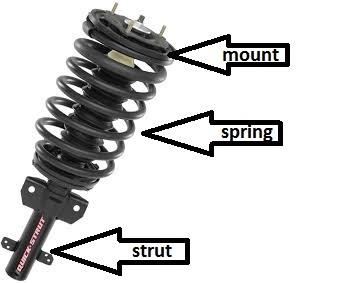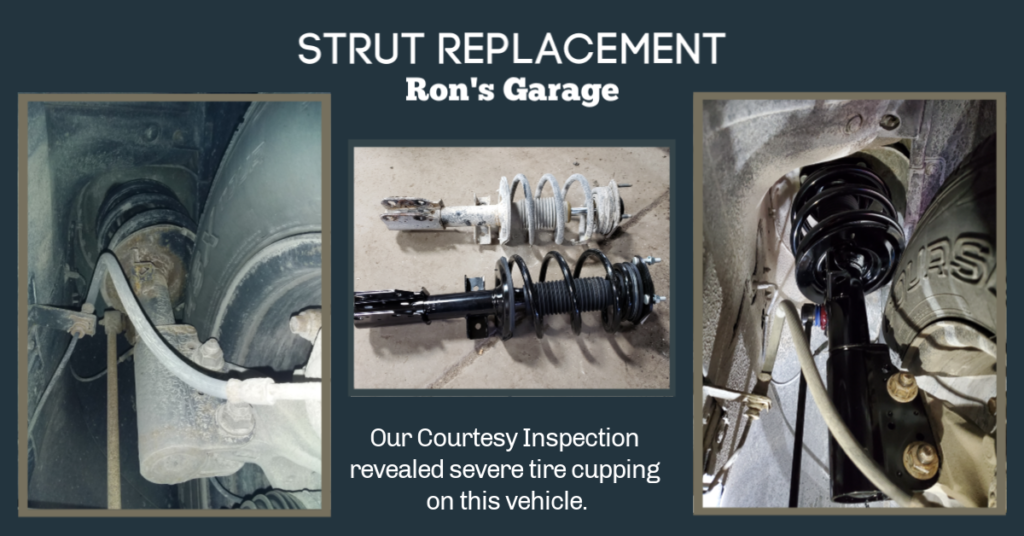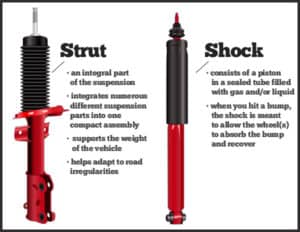To tell if you need new struts, pay attention to your car’s ride quality and stability. Also, watch for excessive bouncing and uneven tire wear.
Having well-maintained struts is crucial for your vehicle’s handling and safety. Over time, struts can wear out and lose their effectiveness, leading to poor performance on the road. If you notice any signs of deterioration, it’s prudent to have your struts inspected and, if necessary, replaced by a professional mechanic.
Regularly checking your struts can help prevent potential safety hazards and maintain optimal driving conditions. Keep reading to learn about the common warning signs that indicate it’s time to consider replacing your struts.

Credit: ronsgaragea2.com
Signs Of Worn Out Struts
Noticing signs of worn-out struts is crucial for safe driving. Clues include excessive bouncing, uneven tire wear, and nose diving during braking. If you experience these, consider replacing your struts.
Uneven Tire Wear
One of the initial signs indicating the need for new struts is uneven tire wear. When your struts are worn out, they are unable to properly support the weight of your vehicle, causing uneven distribution of weight on the tires. As a result, certain parts of the tires experience more friction and wear, while others remain relatively untouched. You can easily spot this issue by inspecting your tires for uneven tread wear.
Uneven tire wear can take several forms, including:
- Cupping or scalloping: This occurs when patches of tread are significantly lower or higher than the rest, resembling small cups or scoops.
- Feathering: Feathered edges on the tread, where one side of the tread blocks is significantly smoother or more worn than the other side.
- Shoulder wear: Excessive wear on the shoulder of the tire, typically caused by struts that are no longer able to keep the tire properly aligned.
Keep in mind that uneven tire wear can also be caused by other factors such as misaligned wheels or improper tire inflation, so it’s always wise to have a professional inspection to pinpoint the exact issue.
Excessive Bouncing And Swerving
Another clear sign that your struts may need replacing is excessive bouncing and swerving. When struts wear out, they lose their ability to absorb shocks and vibrations, causing your vehicle to bounce excessively, especially when driving over bumps or uneven road surfaces.
If you notice your vehicle bouncing excessively, it could indicate that the struts are no longer providing the necessary dampening effect, leading to an uncomfortable and potentially unsafe ride. In addition to bouncing, worn-out struts can also cause your vehicle to swerve or drift to one side when braking or turning.
It’s important to address these issues promptly, as worn-out struts can negatively affect your vehicle’s stability and handling, leading to decreased control and increased risk of accidents.

Credit: ronsgaragea2.com
Checking Strut Performance
Checking strut performance is essential in ensuring the safety and stability of your vehicle. By paying attention to the signs of worn-out struts, you can address potential issues before they escalate. Two key methods for evaluating strut performance are visual inspection and a road test.
Visual Inspection
A visual inspection of your struts can provide valuable insight into their condition. Look for any signs of leakage, dents, or damage to the strut housing. Additionally, check for worn rubber bushings and mounting hardware. Any of these issues could indicate that it’s time to replace your struts.
Road Test
Conducting a road test is another effective way to assess the performance of your struts. Take your vehicle for a drive over various road surfaces, paying close attention to its handling and stability. If you notice excessive bouncing, a bumpy ride, or difficulty maintaining control, it could be a sign that your struts need to be replaced.
Importance Of Timely Replacement
It is crucial to understand the importance of timely replacement when it comes to the struts of your vehicle. Ignoring the signs of worn-out struts can lead to safety hazards and discomfort while driving. Let’s delve into why keeping an eye on your vehicle’s struts is essential for your safety and comfort.
Enhanced Safety
Worn-out struts can compromise the safety of your vehicle. The struts play a vital role in maintaining stability and control, especially during sudden maneuvers and braking. Failing struts can result in decreased traction and an increased risk of losing control on the road, especially in adverse weather conditions. It is crucial to stay proactive in replacing worn struts to ensure your safety and that of other road users.
Improved Ride Comfort
The condition of your struts significantly impacts your ride comfort. Worn-out struts can lead to a bumpy and uncomfortable driving experience due to reduced suspension effectiveness. By promptly replacing the struts, you can enhance your ride comfort and enjoy smoother handling and reduced vehicle vibrations, making your driving experience more pleasant.

Credit: www.youtube.com
Diy Vs. Professional Service
When it comes to the suspension system of your vehicle, the struts play a crucial role in providing a smooth and stable ride. Over time, however, these components can wear out and become less effective, impacting the overall performance and safety of your vehicle. So, how do you know if it’s time to replace your struts? In this article, we’ll explore the signs that indicate the need for new struts and discuss whether you should opt for a DIY replacement or seek professional service.
Diy Replacement
If you have some experience working on cars and possess the necessary tools, replacing your struts yourself could be a viable option. It can be a rewarding project and potentially save you money. However, it’s important to be aware of the challenges involved to ensure a successful DIY replacement.
Before diving into the DIY route, consider the following:
- Do you have the appropriate tools and equipment?
- Can you access step-by-step instructions or video tutorials?
- Do you feel confident in your mechanical abilities?
Replacing struts typically requires lifting the vehicle, removing various components, compressing springs, and aligning the new struts correctly. It’s crucial to follow proper procedures to ensure your safety and the effectiveness of the replacement.
Professional Mechanic
If you’re unsure about tackling the replacement yourself or lack the necessary tools and experience, it’s best to leave it to the professionals. A professional mechanic has the expertise to diagnose any underlying issues, recommend the right struts for your vehicle, and perform a precise installation. While this option may involve additional costs, it guarantees a high-quality and thorough job.
Here are some reasons to consider professional service:
- They have access to specialized tools and equipment.
- They can provide warranties on the parts and labor.
- They can potentially identify other worn-out components in the suspension system.
- They can ensure proper alignment and balancing for optimal performance.
Choosing a professional mechanic can offer peace of mind, knowing that a trained and experienced individual is handling the replacement of your struts.
Cost Of Replacing Struts
If your car is experiencing a bumpy ride, excessive bouncing, or difficulty in steering, it may be a sign that you need new struts. Replacing struts can cost anywhere between $400 and $900, depending on the make and model of your vehicle.
Factors Affecting Cost:
Several factors can impact the cost of replacing struts on your vehicle.
- Vehicle make and model
- Quality of struts
- Labor costs
- Location of the repair shop
Average Price Range:
The cost of replacing struts can vary depending on the above factors.
| Low-End | High-End |
|---|---|
| $200 | $1,500 |
Always get quotes from multiple shops to compare prices.
Frequently Asked Questions On How To Tell If You Need New Struts
What Are The Symptoms Of Bad Struts?
Symptoms of bad struts include excessive bouncing, nose-diving when braking, uneven tire wear, and a rough or bumpy ride. If you notice these signs, it’s essential to have your struts checked by a professional mechanic as soon as possible to avoid potential safety hazards.
How Do You Know When Struts Need To Be Replaced?
You’ll notice your car feels bumpy, unstable, or noisy, especially when going over bumps or turning. Additionally, if there’s leaking hydraulic fluid or the vehicle dips forward when stopping, it’s time to replace the struts. Regular inspection is key to maintaining safe and smooth driving.
How Do I Test My Struts?
To test your struts, you can perform a visual inspection for leaks or damage. Also, bounce each corner of your vehicle to check if the struts are worn out or weak. If there are any issues, consult a professional mechanic for proper diagnosis and repair.
Can You Still Drive With Bad Struts?
Driving with bad struts is dangerous and can affect your vehicle’s handling. It’s best to get them fixed as soon as possible.
Conclusion
After reading this comprehensive guide, you should now have a better understanding of how to determine if your vehicle needs new struts. By paying attention to the signs such as excessive bouncing, increased braking distance, and uneven tire wear, you can take proactive measures to ensure your safety and optimize your vehicle’s performance.
Don’t delay in addressing any issues with your struts, as neglecting them can lead to further damage and costly repairs. Stay informed and maintain your vehicle’s suspension system for a smooth and comfortable ride.
